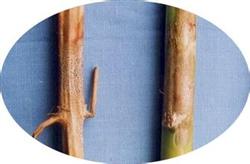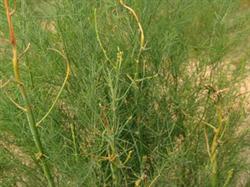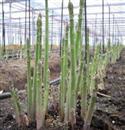Harm and control of asparagus diseases and insect pests

In recent years, with the continuous expansion of asparagus planting area, the damage degree of asparagus disease has become more and more serious, which has caused a lot of losses to the majority of bamboo shoot farmers. The main diseases of asparagus are: stem blight, root rot, brown spot, stem blight, shoot blight and so on. The common diseases and their control measures in the growth process of asparagus are introduced as follows: 1. Stem blight: stem blight is mainly on the main stem at the initial stage, infiltration and discoloration spots appear more than 50 cm from the ground, and then form light green or even grayish brown, and then expand to form fusiform or strip. The edge of the spot is reddish brown, the middle is slightly concave grayish brown, and then the spot can continue to expand, showing a large reddish brown edge and gray-white spot in the middle, with dense needle-like black dots, that is, conidium. The disease spot can go deep into the medulla, and after a circle around the stem, the upper stem will lose water and die. Prevention and control methods: take comprehensive measures, compress the base of bacterial sources and carry out prevention in advance, that is, giving priority to drugs, comprehensive prevention and control, preventing diseases without seeing diseases, increasing production and income. 1. Mulching plastic film or straw in the field can prevent the disease from splashing rain. 2. Properly control the growth of the plant and don't overflourish. 3. Cleaning. Thorough removal and burning of the remains of diseased plants is an important link to depress the source of infectious bacteria and control the disease. 4. Increase the application of potash fertilizer. The application of potash fertilizer 20 Mu 40 kg per mu, the disease prevention effect is 19.88% Mui 44.55% .5, apply more organic fertilizer. According to the fertilizer requirements of asparagus, the ratio of nitrogen fertilizer, phosphate fertilizer and potassium fertilizer should be 10%, 7% and 9%, and 5200 kg of organic fertilizer should be applied every year, and attention should be paid to ploughing and weeding, drought and drainage. 2. Root rot: root rot invades the fleshy root, causing soft tissue and stele rot of the root, leaving only the epidermis. The surface is reddish purple and, in severe cases, is covered by hyphae and is shaped like purple velvet. After the disease, the stem grew short, the stem branches turned yellow and the whole plant withered. Prevention and control methods: the land that used to be orchard and woodland should not be planted asparagus within 3 years, because root rot often becomes the breeding ground of pathogens. Strengthen fertilizer and water management, increase the application of organic fertilizer, promote strong growth and significantly enhance disease resistance. Diseased plants should be dug up in time, and 20% lime water should be used for soil disinfection. 3. Brown spot: it mainly occurs on the stems, branches and pseudo-leaves of young plants at seedling stage and shortly after planting, causing the mother stem to die and the pseudo-leaves to wither and fall off. At the beginning of the disease, there were most small purple-brown spots, the disease spot gradually expanded, the center became gray, the edge was purple-brown wheel, the gray-white part of the disease spot was dense with black conidia, and white powder spores were scattered when wet. Most of the disease spots on the stem were enlarged and connected and turned into oval spots. Control methods: with reference to the methods of controlling stem blight, while controlling stem blight, brown spot has also been well controlled. 4. Blight: it mainly harms seedlings and young plants. most of the pathogens infect the stem base and roots of seedlings from topsoil, and the damaged parts are dark brown. Control methods: the previous crops are cotton, potatoes and other easily contagious land should not be used as nursery land. Sufficient bottom water was given before sowing, and there was no or less irrigation within 20 days after the seedlings were unearthed. In the early stage of the disease, 45% of Shenanning 2000 times the solution irrigated the root, which can play the role of sterilization and seedling protection. 5. Tip blight: small spots are formed on leaves, branches and stems. Under moist conditions, black mildew grows on the surface of the lesion. The disease spots formed on the tender stems are lighter in color, the diseased leaves fall early in advance, the tender shoots die, and the dead tender shoots show black-brown rot symptoms when it is wet. Prevention and control methods: chemical control is mainly adopted. The use of Shuangjisheng or mancozeb has a good control effect. Agricultural control is mainly to do a good job of cleaning in winter and spring, do not plant onions and garlic in or near asparagus fields. In a word, the occurrence of asparagus diseases and insect pests is affected by many factors. Only by formulating reasonable cultivation measures and timely prevention can we effectively reduce the occurrence and harm of asparagus diseases and insect pests and achieve high yield, high quality and high efficiency of asparagus.
- Prev

Control techniques of asparagus diseases and insect pests
Asparagus stem blight and brown spot are the main diseases of asparagus. At present, there is no specific medicine for prevention and treatment. Practice has proved that the comprehensive disease prevention strategy based on agronomic measures supplemented by chemical control can achieve twice the result with half the effort. The specific methods are as follows: 1. Timely heart-picking to prevent lodging. Gourd.
- Next

How to use drugs to control organic asparagus diseases and insect pests
(1) the common diseases of asparagus are quenching, stem blight and carbon gangrene, and the main pests are beet armyworm, cabbage armyworm, corn borer, aphids, planthoppers, ground tigers, grubs and other underground pests. (2) in the process of production, the control methods should be from the whole ecosystem such as crop-disease and Cordyceps sinensis.
Related
- Where is it suitable to grow horseradish in China? it is expected to see the middle altitude horseradish in Alishan.
- How to prevent tomato virus disease reasonably? (Control methods included)
- Many people like to plant towel gourd on the balcony. What are the main points of this method and management?
- What crops can chili peppers be mixed with?
- Fertilization techniques and matters needing attention in Tomato
- What are the grafting techniques for peach seedlings in spring?
- Harm and control methods of root swelling disease of Chinese cabbage
- What are the pests of sweet potatoes? How to prevent and cure it?
- Symptoms, causes and Control methods of navel Rot in Tomato
- The cause of "Cucumber rotten bibcock" in Farmers' planting Cucumber and its Control Plan

